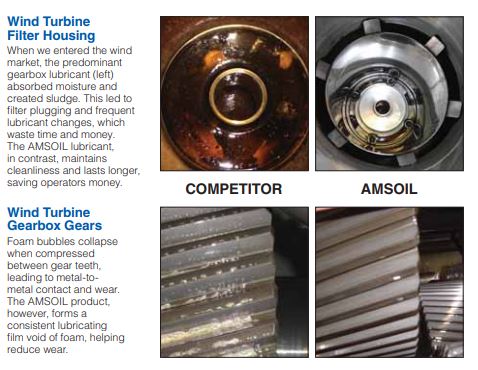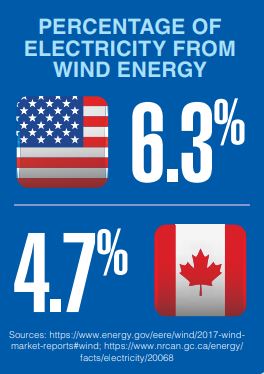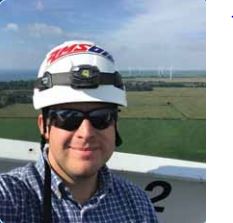AMSOIL – Making Wind Industry Profitable
Nearly 58,000 wind turbines dot the American landscape. Nearly 50 percent of those now use AMSOIL synthetic lubricants in their gearboxes. Here´s the story of how we shook up the wind industry – and how it benefits you.
We dove into the wind market more than a decade ago for the same reasons we enter most markets: to solve a problem. At the time, wind farm managers were struggling to find a wind turbine gearbox lubricant capable of delivering superior protection without requiring frequent and expensive changes. Fully appreciating the challenge requires understanding how a wind turbine gearbox works.
Wind turbine gearbox 101
If you’ve ever driven past a wind farm, you’ve noticed how slowly wind turbine blades turn – typically 10-18 rpm. The generator inside the turbine’s nacelle (the housing atop the tower), however, requires up to 1,500 rpm to produce the turbine’s rated power. The gearbox increases rotational speed from the low-rpm turbine blades to the high rpm electric generator. It uses a variety of planetary gears, helical gears and bearings to accomplish this.
All those moving parts must withstand tremendous torque and high speeds while operating in hot, humid, wet environments or sub-zero temperatures – sometimes all of the above throughout the year. Gear lube can quickly fail in such conditions.
That was precisely the case with the predominant wind turbine gear lube on the market at the time. It tended to absorb moisture, which led to additives separating from the lubricant (called additive dropout). This leads to a form of fatigue failure called micropitting that can cause gears to fail. In fact, at that time, a wind-farm manager could expect 30-40 percent of the gearboxes in his turbines to fail within three to five years. This is unacceptable considering that, along with crane costs, replacing a wind turbine gearbox costs up to $500,000.
To help prolong gearbox life, managers resorted to frequent gear-lube changes – typically every two to three years. That may not sound unreasonable until you understand the toll a single lubricant change takes. First, the turbine has to be shut down, which reduces profitability. A team of trained technicians must then mobilize a specially designed truck capable of pumping the new lubricant to the gearbox (up to 300 feet above the ground) while draining the old oil. Not only that, the gearbox requires flushing to remove contaminants, which adds additional time and complexity. Changing oil in just one gearbox can cost thousands of dollars. Changing oil in every gearbox on a wind farm quickly becomes cost-prohibitive.
Building a better lubricant
We went to work developing a better gear lubricant. In addition to years of lab testing, the lubricant was installed in seven wind turbines located in the Midwest. The turbines had been using a competitor’s oil and were in rough shape. In fact, the wind farm manager later told us he had expected the gearboxes to fail within six months of testing. Instead, the AMSOIL product performed well and the turbines continued running. We monitored lubricant and turbine performance every month. The process uncovered several costly hurdles to servicing wind farms. For example, personnel must complete safety training, earn certification and carry millions of dollars of liability insurance simply to set foot on a wind farm, let alone climb a tower. In addition, wind farm managers expect suppliers to act as technical consultants and help them develop procedures for improving efficiency. We quickly realized that servicing wind farms requires a team of full-time, specialized experts. That’s why we handle sales to wind farms corporately rather than through independent Dealers.
Despite years of severe service, the lubricant continued performing flawlessly. In total, the lubricant was in use for nine years without being changed and without incident. Recently, the wind farm elected to decommission the seven turbines to perform infrastructure upgrades; however, the lubricant was still in great condition and performing well until its final day of use.
Our test data impressed the biggest and most prestigious manufacturers in the world. We have since earned approvals from nearly every major turbine manufacturer and gearbox manufacturer, including Siemens*, Vestas*, Flender*, Nanjing Gear* and ZF*. This was a huge step since wind farm managers won’t use non-approved oils in their turbines given the astronomical costs should something fail. Our gear lube is also the factory fill for one of the world´s largest turbine manufacturers, as well as the run-in oil at nearly every major gearbox OEM that supplies the global wind industry. We continue to work toward earning more factory-fill agreements. AMSOIL products are now installed in nearly 50 percent of all wind turbines in the U.S., in addition to turbines in Europe, China, India, Brazil and more. We’re proud to say that AMSOIL products have never caused a gearbox failure. That’s a tremendous achievement considering the state of the industry prior to our arrival.
What good is it for me?
You might be thinking, “That’s great for AMSOIL INC., but how does it help my Dealership?” There are several ways.
1) Increased expertise influences all AMSOIL products
The insights we’ve gleaned from our involvement in the wind industry influence additional product formulations. For example, we applied the advanced chemistry of our wind-turbine gear lubricant to the passenger car/light truck market via SEVERE GEAR® Synthetic Gear Lube. The chemistry that impressed the toughest critics in one of the world’s most demanding industries influenced the chemistry in each easy-pack of SEVERE GEAR. Developing and testing synthetic technology in wind turbines builds our knowledge and helps us continue to improve our full line of world-class synthetic lubricants.
To our Omaha customers – Yes – this puts these products way ahead of the competition. You can see for your self in seat of the pants tests.. Severe Gear Differential Fluid = more power to the wheels and a LOT more fuel saved.. Not to mention saving your own time in maintenance.
2) Brand validation
Our leadership role in the wind industry strengthens the AMSOIL brand and helps validate your efforts in the field. Additionally, it shows that our size and influence is larger than some people think, boosting your credibility. Tell prospects and customers that the biggest and most prestigious manufacturers in the wind industry selected AMSOIL from all the lubricant manufacturers in the world to develop a gear lube for their gearboxes. Point out that AMSOIL lubricants are installed in nearly 50 percent of U.S. wind turbines. This level of credibility speaks volumes about our product quality. Ask prospects, “If AMSOIL synthetic lubricants perform that well in wind turbines, imagine how well they can perform in your vehicles and equipment.”
3) Improves company image
While it may not be at the forefront of many enthusiasts’ minds, many customers actively look for companies that support sustainability. By servicing renewable-energy assets and maintaining a leadership role in the industry, we strengthen our image, which reflects well upon Dealers.
4) Helps keep costs down
A single wind farm can require thousands of gallons of lubricants. To meet demand, we purchase increased volumes of raw materials at a time, helping reduce purchasing costs. Manufacturing to meet increased demand also leads to greater production efficiency, which further holds costs in check. We pass the savings on to you and your customers.
We plan to continue growing our presence in the wind industry. It’s a key part of our strategy to diversify and strengthen the company, which ensures the viability of the Dealer opportunity for years to come.
WHY CAN’T DEALERS SELL TO WIND FARMS?
We’re as committed to the Dealer opportunity as ever. But explosing Dealers to the financial and safety risks inherent to the wind industry would be irresponsible. For the following reasons, it’s best for everyone that we handle the wind market corporately.
CUSTOMERS REQUIRE UNPRECEDENTED SERVICE
Selling lubricants is just the start. Businesses must sign complex terms-and-conditions agreements and carry expensive insurance policies. They must also maintain a large inventory of products while providing payment terms. In addition, businesses are expected to develop oil-sampling procedures, obtain oil samples and create gearbox-flushing procedures, among other value-added services. A business is seen as a partner available to help wind-industry personnel uncover ways to maximize turbine efficiency. It must provide on-site technical analysis and actively work to advance the industry, not just sell lubricants. Simply entering a turbine is dangerous and requires extensive training and certification. These restrictions are in place to ensure maximum safety when working in turbines 300 feet high and beyond.
THE MARKET REQUIRES SPECIALIZED KNOWLEDGE
Gearboxes and other components use cutting-edge technologies accessible only to industry experts. Personnel must understand particle-count testing, oil analysis interpretation, troubleshooting and other complex disciplines. Mechanical failures resulting from incorrect product recommendations, for example, can carry liability costs in excess of $500,000 per turbine. Dealers aren’t positioned to absorb this level of risk.
THE MARKET CONTAINS RELATIVELY FEW POTENTIAL CUSTOMERS
While growing, the wind market contains a relatively small number of potential accounts compared to traditional markets. Pursuing a wind farm not only will lead to disappointment, it will distract Dealers from approaching potential customers they’re much more likely to secure.
While there are Dealers who are fully capable of executing aspects of doing business with wind farms, the overall demands and liabilities are too great.
AMSOIL has never caused a gearbox failure. That’s a tremendous achievement considering the state of the industry prior to our arrival.





